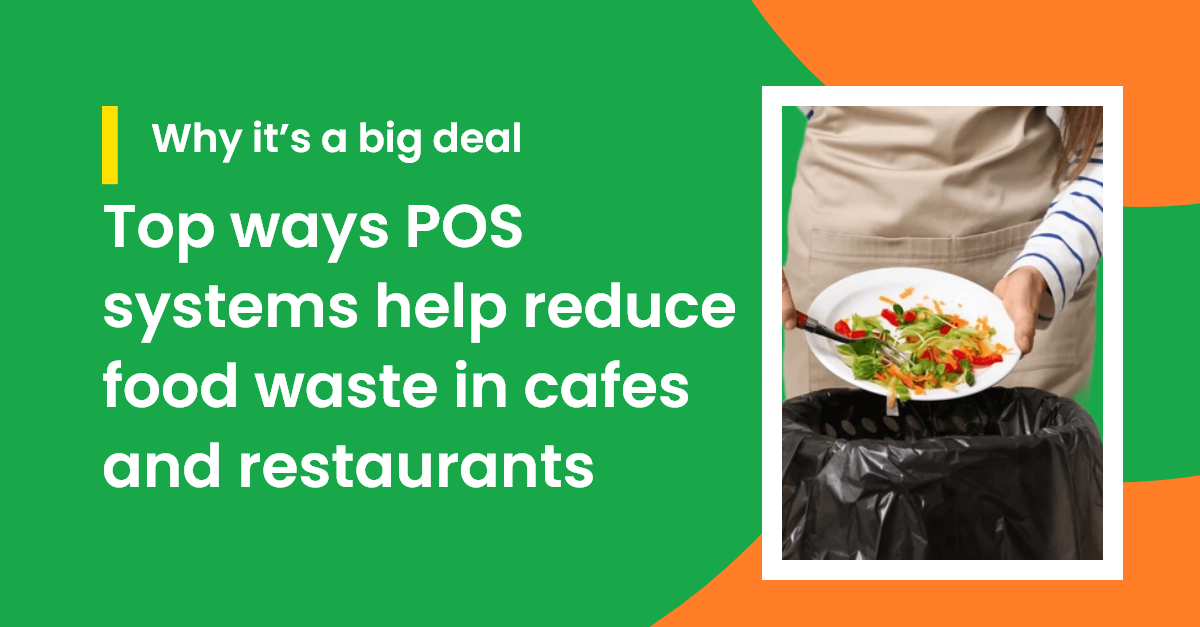Let’s talk about the elephant in the kitchen - food waste. It’s the uninvited guest at every cafe and restaurant, gobbling up profits and leaving a trail of rotten veggies and expired yogurt in its wake. In an industry where margins are slimmer than a wafer-thin biscotti, tossing out perfectly good ingredients, or worse, serving spoiled ones, is a gut punch. Enter the unsung hero of the hospitality world: the POS system. Far more than a glorified calculator, a smart POS is your secret weapon for slashing food waste, keeping your inventory tighter than a chef’s apron, and ensuring your cafe or restaurant runs like a zero-waste dream.
How does a POS pull off this culinary magic? By tackling the trifecta of waste-busting: inventory tracking, portion control, and expiry monitoring. So, pour yourself a coffee (or cold glass of fresh fruit juice, healthier.), and let’s explore how a POS system turns your kitchen into a lean, green, waste-fighting machine.
Why it’s a big deal
Food waste isn’t just a bummer for your bottom line. It’s a real global buzzkill. Restaurants and cafes chuck out billions of pounds of food annually, and every spoiled tomato or forgotten bag of spinach is money down the drain. A smart POS system doesn’t just help you serve better lattes or faster burgers, it’s a precision tool for minimizing waste while keeping your customers blissfully unaware of the behind-the-scenes wizardry. Here’s how it works its magic.
Inventory Tracking: Knowing exactly what’s in your pantry
Ever opened your walk-in fridge only to find a mystery container of something that might’ve been pesto in a past life? A POS system with inventory tracking is like having a hyper-organized secretary who never takes a day off.
- Real-time stock updates: Every time you sell a Ceasar salad, the POS deducts the exact amount of tomatoes, chicken, lettuce and basil from your inventory. No more guessing how many avocados are left or over-ordering because you “think” you’re low on chicken. This precision means you buy only what you need, reducing the odds of ingredients going bad.
- Low-stock alerts: Running out of spinach mid-rush is a crisis. Overstocking it is a waste waiting to happen. A POS sends notifications when supplies dip below a set threshold, so you can reorder just in time. It’s like your fridge texting you, “Hey, we’re down to three carrots, do something!”
- Supplier sync: Some POS systems integrate with suppliers, letting you reorder with a single click based on real-time data. No more late-night manual counts or panic orders that lead to surplus stock.
Portion Control: Serving just right, every time
Portion control isn’t about being stingy. It’s about consistency, quality, and not accidentally turning your signature dish into a compost contribution. A POS system helps you keep portions in check without your chef needing to eyeball every scoop.
- Recipe integration: A POS can store standardized recipes, so when an order for your famous chole comes in, it logs the exact amount of chickpeas and spices used. This ensures every dish is consistent and prevents over-portioning, which can quietly bleed your inventory dry.
- Staff training tool: New line cook dumping half a bag of fries into the fryer? A POS system’s portion data doubles as a training guide, showing staff exactly how much to plate.
- Menu optimization: By analyzing sales data, a POS highlights which dishes are overusing high-cost ingredients. If your blue crab curry is a slow seller but eats up half your seafood budget, you can tweak the recipe or swap it for a more profitable option. Waste down, profits up.
Expiry Monitoring: Catching spoilage before it strikes
Nothing stinks more than tossing out food because it hit its expiry date before you could use it. (Well, maybe the expired food itself, but you get the point.) A POS system keeps a hawk-like eye on shelf life, so you’re not playing Russian roulette with your dairy.
- Expiry alerts: Input the shelf life of your ingredients, and the POS flags items nearing their use-by date. Got milk that’s about to turn? Your POS will nudge you to whip up a batch of lattes or a special smoothie to use it up and prevent wastage.
- First-In, first-out (FIFO): A POS can prioritize older stock in recipes and inventory counts, ensuring you use ingredients in the order they arrived. No more shoving new crates of lettuce in front of the old ones, only to find a science experiment later.
- Waste reports: Some POS systems generate waste logs, showing you exactly what’s getting tossed and why. Spot a pattern of over-prepped salads going bad? Simple, adjust your prep quantities.
Waste less, win more
A smart POS system isn’t here to replace your chef’s intuition. It’s here to make their jobs easier and your business more sustainable. By mastering inventory tracking, portion control, and expiry monitoring, it slashes food waste, saves you money, and lets you sleep better knowing you’re not feeding the landfill. Plus, in an era where customers love eco-conscious businesses, reducing waste is a brag-worthy bonus that can draw in the sustainability crowd.
Do you ever feel like you are running a restaurant like a chaotic mela? Fret not! MyGenie restaurant...
Hey there, naan-trepreneurs! Do you want to take your restaurant's social media presence from mild t...
A single bad review can sour a reputation faster than milk left out on a hot day. Providing an excep...








